In preschool fun and engaging circle time games can teach many crucial skills that children can then use to deepen their play. Eye contact, turn-taking, understanding emotions, and listening are all key skills in life and they are reinforced during circle time! (As well as working through gross motor skills, cognitive skills, language development, social interaction, and more!)
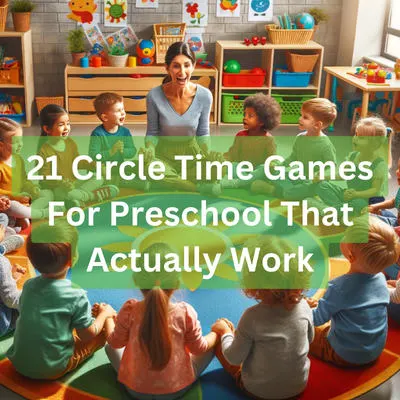
Over the last 5 years I have trained approximately 1,500 early years kindergarten, pre-K, and preschool teachers, teaching assistants, and preschool practitioners we have seen the benefits of short, snappy, fun circle time games.
Today I will share some my favorite circle time activities… but before that I’ll briefly touch on what circle time is, I’ll go through some of the benefits of circle time, then I’ll spend most of the time going through some amazing games you can add to your circle time routine!
What is Circle Time?
Circle time is a fantastic way for young learners. I particularly love circle time to start the day or transition between activities.
Simply put, circle time is a structured time when children gather together in a circle to engage in singing, storytelling, games, or really any activity.
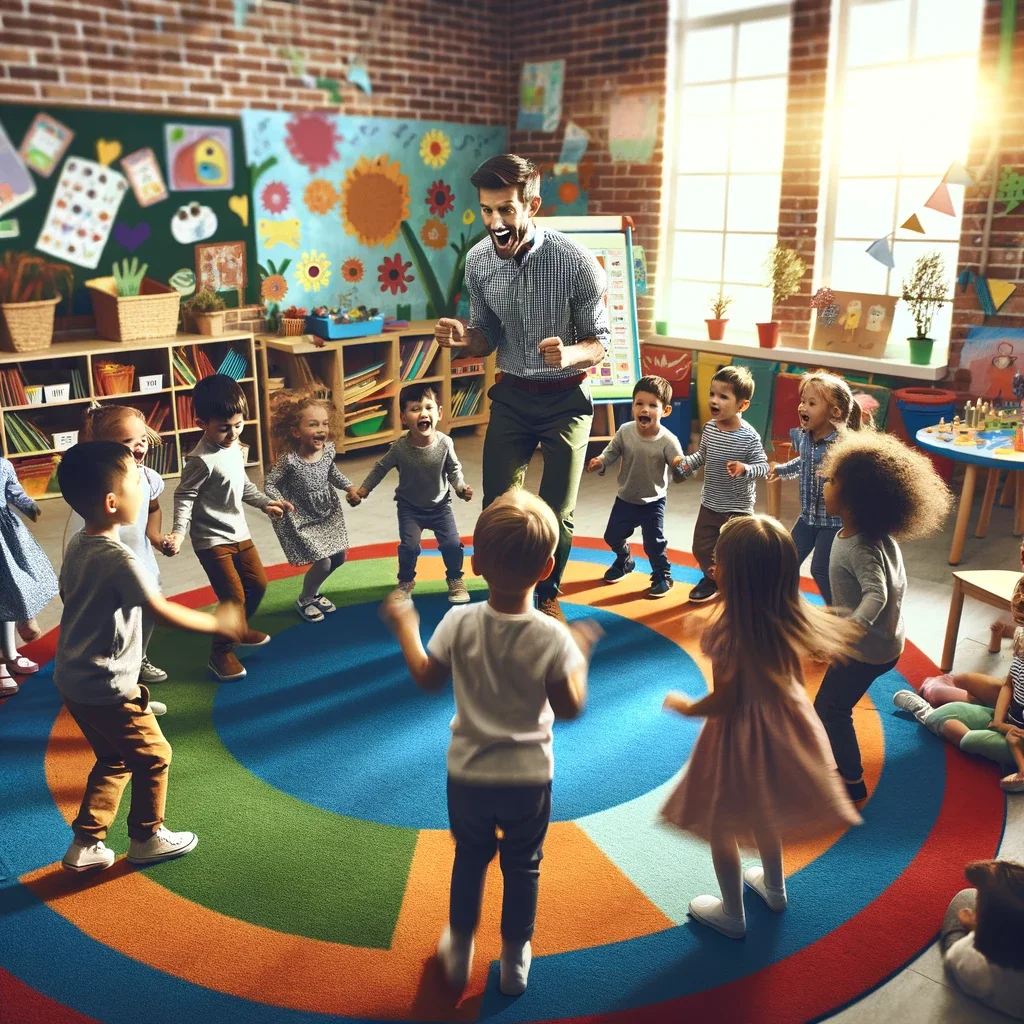
Kids actually LOVE this interactive group time, but it also promotes social skills, communication, and a sense of community. It is an awesome time to introduce our kids to new concepts and reinforce learning in a fun, supportive environment.
The Benefits of Circle Time Games
The intent of this article is to get right to the fun stuff (i.e. the games and activities)! We will add another post on the benefits if you want more detail, but just quickly
Preschool circle time offers truly significant benefits, including enhancing social interaction, improving listening skills, gross motor skills, cognitive development, community building, and fostering emotional intelligence.
It’s a great (and safe) environment for our kiddos to express themselves, learn to participate in group activities, and develop a sense of community and belonging. This time also introduces kids to routine, listening, and discipline in an engaging and interactive way.
While anecdotal data is great, here are a couple of studies worth checking out: Circle Time for Social and Emotional Learning, the value of circle time as an intervention strategy.
The Best Circle Time Games for Preschool
Okay okay … there is the good stuff. I think this is important to define some of the best games because there seem to be so many games floating around that don’t really work that well in reality. This article presents just the games that I have tried and tested, that kids really ‘get’ quickly, the games they will ask for again and again.
These are the cream of the crop from my book – 101 Circle Time Games…That Actually Work! (that you can check out here).
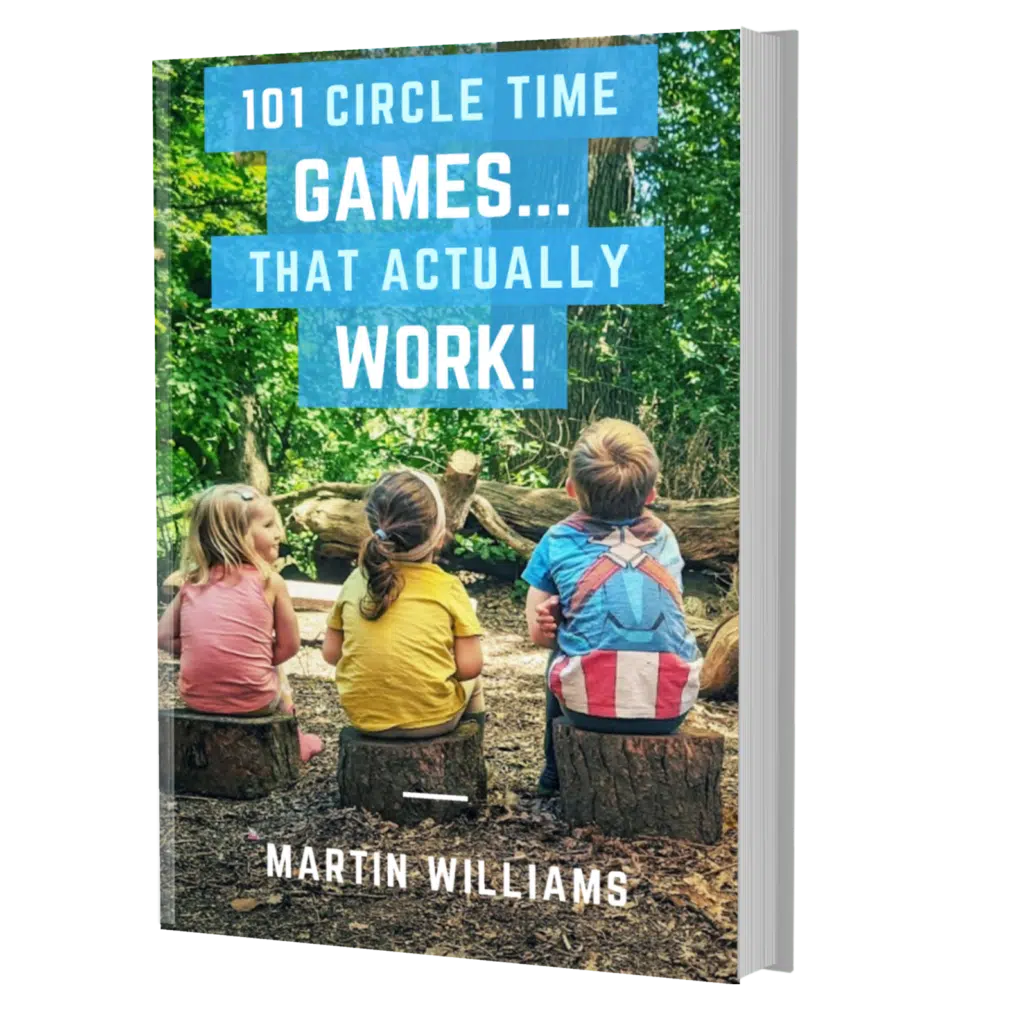
This book offers the very best math circle games, literacy games, physical circle times, mindfulness, circle times, and so much more! Check it out here.
So what are the best circle time games for preschool? Some excellent circle time games for preschool are:
- Snowball
- Don’t Wake The Monkey
- Pass The Rhythm
- Act The Emotion
- Parachute Pairs
- Pass The Potato
- Wonky Donkey
- Baby Bear Game
- Pass The Smile
- Spin The Bottle
- Spare Place
- Picnic Memory Game
- At The Zoo
- Where Is It?
- Pass The Puppet
- Matching Socks
- Pass The Ball Round The Circle
- Change!
- Missing Child Game
- Mystery Object
- Mystery Box
Read on to find a detailed description of each and check out our amazing online courses to help take all of these developmental concepts to the next level. But for now, read below to help to bring your preschool circle times to life!
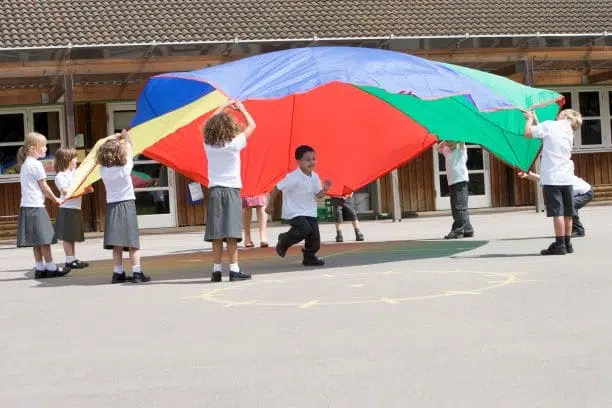
1.Snowball
This game can be adapted for circle time in many different ways.
The idea is that you have pieces of paper that have pairs of matching pictures on. The adult just draws pictures on themselves. For example, they could be simple pictures of shapes. You could have two separate pictures of a triangle, a square, a circle, and a pentagon etc. You need as many pictures as you have in your classroom or home. For example, if you have 12, you need 6 pairs of matching pictures.
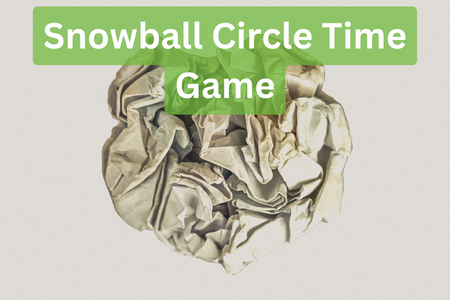
The pictures could be anything. Nice easy ones are things like numbers, shapes, letters, animals, weather, or emotion faces.
To begin circle time, each little one is handed a piece of paper each. They crumple it into a ball – a “snowball” – and throw it into the middle of the circle. Then they have to go and pick up a ball. The only rule is that they can’t pick their own snowball up. They must pick up someone else’s!
When they pick up their new snowball, they un-crumple it and then try to find their partner. If you have an odd number of children, you will have someone without a partner, and this is normally the ‘champion’!
Also they will usually have to go and stand next to a partner that is not their best friend.
Materials Needed: paper & drawing suppliers (crayons/markers)
Learning Objectives: Many skills are developed through this game. They have to show each other their paper, they must look at other people, they most follow direction, and may learn about asking for help. and it helps to ask.
2. Don’t Wake The Monkey!
Don’t wake the monkey is a truly fun way to teach patience and emotional control!
You don’t need a monkey for this game – any puppet or teddy will work fine. I just happen to use a large monkey puppet.
Put the puppet or teddy into the middle of the circle. They are ‘asleep’.
Then get either a tambourine, bells or keys. In a moment you are going to pass these around the circle as silently as possible.
Before that, though, there is a chant to all say together in a whisper. It goes like this:
Little monkey’s sleeping on the ground.
Sh! Sh! Sh!
We must not wake him with a sound.
Sh! Sh! Sh!
Then, as silently as possibly, try passing the instrument around the circle. The children have to work together, and try and get it all the way around.
Another way of playing this game, is to split into two teams. The two teams form two circles, each with their own instrument and sleeping puppet in the middle.
The two teams then battle it out, and see which one can be the quietest passing the instrument around. This is a great variation for competitive children.
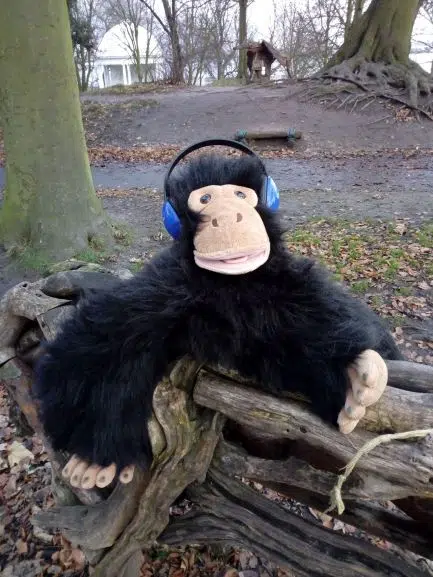
3.Pass The Rhythm
Pass the rhythm is one of the best circle time activities for early phonics as well as behavior.
There are two ways of playing it, an easy way, or a slightly harder way. The harder way is generally much better for social skills and turn-taking.
In the “simple game” version, the adult makes up a quick rhythm (maybe limit them to three hits), using different parts of the body. For example, tap your head once, and then your knees twice. The children must listen carefully then copy the same rhythm!
Then move on to another rhythm, for example, tap your shoulders, then legs, then feet. The children copy again!
When they become good at that, then you can move on to the harder version of the game. In this the children will make up their own rhythm. Start with the first child in the circle. They make up a rhythm of 3 actions, for example, tap head then shoulders then legs. The other copy. Go around the circle, taking it in turns letting each child have one attempt.
If you’d like to find out a whole lot more rhythm games, then why not check out my article the essential guide to rhythm sticks games, featuring at least 12 ideas.
4. Act The Emotion
Have three emotion cards in the middle of the circle – happy, sad, angry. You just draw a happy face, sad face and angry face on pieces of paper.
The adult goes first to show them what to do. They stand up and act out being one of these emotions. For example, if it is sad they bow their head, hunch their shoulders, mooch around and do a sad face. The children point to which emotion they think you are feeling.
Then it is their turn. One at a time a child will stand up and act out one of the emotions. The others try to guess which one it is. Talk about the body language and facial expressions. This is a creative way to teach emotion!
5. Parachute Pairs
This pairs game is a nice simple one to try. The idea is all everyone holds the parachute at about waist height. Then you pick two children, by saying their names. They are the two children that are going to swap places.
The idea is that the adult says ‘1,2,3!’ On the ‘3’ all the players lift the parachute up over their head as high as they can, so the chute mushrooms up in the air.
At that moment the two children run under the parachute and swap places.
Then bring the parachute down and pick the next two children. Repeat the same process.
A slightly harder version of this game is the fruit salad game. In this you give everyone a name of a fruit. Go round saying ‘Apple, banana, strawberry, pear’, or something like that. Have about four fruits, and give them out equally so you’ll have roughly the same number of children each being an apple or a strawberry.
Then go ‘1,2,3!’ On the 3 lift the parachute and shout a fruit name, for example ‘strawberry’.
The idea is that all the strawberries will run underneath the parachute and swop places. Then repeat for other fruits.
This is a bit harder just because the children have to remember what fruit they are. For some this is an extremely tricky task.
Did you know you can also play all sorts of math and phonics games with parachutes?! Try reading my favorite 14 Parachute Math Games. Also, one of the best ways of keeping phonics exciting and engaging is by trying some of these 10 Brilliant Phonics Parachute Games.
There is also a whole chapter on the very best parachute circle time games, that you can find in my book 101 Circle Time Games…That Actually Work! (which you can check out here).
6.Pass The Potato
This game is bit like pass the parcel, only you use a potato! All that is required is a potato and some music.
Put some music on and pass the potato around the circle. When the music stops, whoever is holding the potato is out and has to stand up and sit outside the circle. Continue until you have a champion.
Some react better to being ‘out’ than others. But this is a great safe space opportunity to work on regulating emotions.
7. Wonky Donkey!
This is a really fun game, that helps children listen to the voices of others.
Start with one individual who is the Wonky Donkey! They come and sit in the middle of the circle and put a blindfold on. They also put on either an old shirt, or an apron or a bib. Whatever you have to hand will work.
The idea is that you pick one child to come up and hold on to the back of the child’s shirt or apron. This is the donkey’s ‘tail’. That person shakes the ‘tail’ and shouts ‘Wonky Donkey!’
The idea is that the Wonky Donkey has to guess who has shook their tail!
This game helps them to begin to recognize the voices of their friends. It also tunes them in and gets them listening.
8. Baby Bear Game
This is one of my favorite listening games.
To play it you need a blindfold, a jar of honey and a noisy instrument of some sort – usually a tambourine or some keys work well.
The idea is that you get a child to come and sit in the middle of the circle. They are Baby Bear, and they put a blindfold on so they can’t see. Baby Bear is ‘asleep’.
Put the honey behind Baby Bear.
There is now a chant that goes like this:
Isn’t it funny how a bear likes honey!
You give the tambourine to any of the children in the circle. Their job is to stand up as quietly as possible, and sneak over to Baby Bear, pick up the honey, and sneak back to where they are sitting with it.
The tricky part is that they have to try to hide both the honey and the tambourine behind their back.
They keep their hands behind their back, and everyone else puts their hands behind their back as well, so anyone could be the thief!
Then Baby Bear wakes up (takes the blindfold off). The bear has three guesses to work out who the thief is.
There are usually lots of clues if everyone stays quite – footsteps, little jingles from the tambourine and other noises like that.
If the children are having problems putting the tambourine behind their back, then the easier version of the game is to swop the tambourine with honey, so you take the honey back but leave the tambourine behind the bear. You get less sound clues this way, but it is easy for very young children to accomplish.
There seem to be many variations of this game, and I have seen it played with the Bear as a pirate, with someone robbing his treasure, or as a Giant and someone robs his keys. The basic skills behind all these games are the same.
9.Pass The Smile
None of these circle time activities can make you smile quite like this game! This is an activity that is great for eye contact, turn-taking and thinking about emotions.
The adult to begin smiles at the first child. They ‘pass’ the smile to the child next to them, by looking at them and smiling. Then the children will pass the smile all the way around the circle. You may need to give the occasional child a bit of a reminder to look or pass it on. Once everyone has smiled the game ends!
However, you can keeping going by just doing a do different version of the game! You could pass a frown, a wink, a nod or some other facial expression. This is an amazing activity for thinking about emotions, and what our faces do when we are feeling different ways.
10. Spin The Bottle!
This is the child-friendly version of this classic game.
All you need is an empty bottle. This game works better on a harder surface, such as wood or laminate flooring. The bottle doesn’t really spin enough on a carpet.
Put the bottle in the middle of the circle, and a child to come and spin it. They spin the bottle and shout one child’s name. That child has to jump up and pick up the bottle before it stops spinning.
Then they spin it and shout a child’s name, and just carry on with the next child repeating.
11. Spare Place
In this game you need cards with pictures on. The pictures all have to be different. A good example would be to use pictures of animals. You could have a full range of animals – a cow, a horse, a dog, a cat, a mouse etc.
Sit in a circle, but have one big space in the circle, easily big enough for a child to sit in.
Give each child a picture of an animal, and you also have one spare picture that goes in the space.
Say an animal name. The child holding that picture will move to the spare space. They then say an animal name, and that child will move to the space that the first child has vacated.
12. Picnic Memory Game
There are many variations of this classic memory game, but here is just one way of playing it.
For this game you need a bag of simple pretend (or real) food and a picnic hamper or box of some sort to put them in.
There is an easy and a hard version of the game. For the easy version, what you do is take one piece of food out of the bag first. For example, let’s say it is an orange. The first person would say, ‘For our picnic we took an orange.’
They put the orange in the box so everyone can see it.
Then the next person goes. They take a piece of food out, for example a banana, and say ‘For our picnic we took an orange and a banana.’
They put the banana next to the orange and the game continues.
This is much easier than the hard version, because you can see the food, and just need to be able to say it in a sequence.
For the harder version, the idea is that you put one piece of food into the box and then close the lid so you can’t see it.
For example, the first person says ‘On our picnic we took an orange.’ They put the orange in the box and close the lid.
Then the next person says, ‘On our picnic we took an orange and a banana.’ They open the lid and put the banana next to the orange, then close it.
There is lots of memory and listening and looking required in this game. You may want to start with just 3 or 4 objects, though some children are amazing at remembering a huge number.
Just see how it goes, and make the game easier or harder as required.
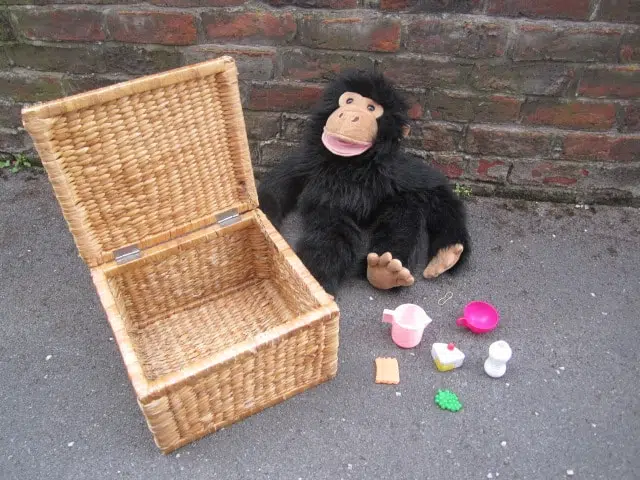
There is a whole chapter on ‘memory circle time games…that actually work’ in my book 101 Circle Time Games…That Actually Work.
13. At The Zoo
This is another variation of the picnic memory game.
Have a story bag with animals in. Say ‘In the jungle, we saw a (pick one out) an elephant!’ Pass it to next person. ‘In the jungle we saw an elephant and a tiger etc etc.’ Keep going just like that.
There are many variations that you can play on this classic memory game. All you need is some kind of objects in a bag and some sort of context. Other ideas could be a bag of vehicles. Say something like ‘On the road I saw a …lorry.’
You could use dinosaurs, or superheroes, or whatever you like. Be creative! Whatever the children are interested in will get the best response.
14. Where Is It?
“Where is it” is a fun musical instrument circle time game!
Have one child sitting in the middle of the circle. They put a blindfold on.
Then get a noisy instrument – it could be a tambourine or keys or something similar. The idea is then that the children pass the noisy instrument around, all giving it a shake when they are holding it before passing it on to the next person.
When the adult says ‘stop’ the person holding the tambourine holds it silently.
The child in the middle is going to try to point to whoever they think is holding the instrument. Then do it again.
15. Pass The Puppet
This is a great activity that can be adapted in many ways, and is one that I play a lot, possibly the most out of this article.
Have a puppet, and it is good to have some sort of story. For example, the puppet is happy because his friend has shared their toys. You basically have some sort of them. The puppet might be sad for a reason, or worried, or anything like that.
Pass the puppet round, and everyone says one thing that makes them happy, or sad, or appreciative of a friend, or whatever the theme is. You can only speak when you’re holding the puppet!
If you’re interested in reading more puppet games, then check out my article about the 22 best uses of puppets in teaching.
16. Matching Socks
Some group games are great for mixing and working with people that you wouldn’t normally work with.
The matching socks game is a great example of this. The idea is that you have lots of pairs of socks. The sock pairs all need to be a different design, and you need at least one sock per child.
Give the socks out! The children stand up and try to find their matching sock partner.
This gets them thinking about color and pattern. It also gets them looking at their friends, and also standing next to a partner that they wouldn’t necessarily choose to stand next to.
17. Pass Balls Round The Circle
Simple ball games are great for young children, and this is about as simple as it gets.
The very simplest way of playing this game is to have one ball. All you do is pass the ball around the circle.

The slightly harder version of this game is to have several balls. You pass these round the circle!
This game is just the tip of the iceberg when it comes to ball games that preschoolers love. Why not check out my 30 Preschool Ball Games For The Whole Curriculum.
The book contains a whole chapter on simple and imaginative passing games like this.
18. Change!
To extend this game yet again, pass several balls round, but when you say ‘change’ the balls all have to go in the opposite direction. This is not as easy as it sounds!
The next stage of this game is to have two colors of balls. For example, have three blue balls and three yellow balls. The blue balls are going to go one direction, and the yellow balls are going to go in the opposite direction.
See how you get on! The tricky bit is that some children will get two balls at once. They will have to switch them over to keep them going.
When, and if, the children are doing well at this game, you can then introduce a ‘change’ again. So when the balls are all going around in the two directions, say ‘change’, and see if they can move them back the other way. This takes a lot of teamwork and cooperation! It also is good for conflict resolution, as some children will naturally get it wrong, and you will be encouraging children to support each other.
If you liked the sound of these simple ball games, you will be pleased to know that I have written 30 Preschool Ball Games for The Whole Curriculum. There is a host of ball games for math, phonics, physical development and more – the whole curriculum. Why not take a look?
19. Missing Child Game.
This is a great game for eye contact.
The idea of this game is that all children close their eyes. This is the tricky bit! They have to try and do it properly, and no cheating!
Then tap one child on the shoulder. That child is going to go and hide somewhere where the others cannot see them.
Then tell the children to open their eyes. Who has gone missing?
This moment is great for them all to be looking into each other’s faces to see who is there and who isn’t. Eye contact is a massive target for so many children, and this game really helps this skill. Looking for more eye contact games? Why not check out my 12 Fantastic Eye Contact Group Games .
There is a version of this missing child game using a parachute. In that version the children sit around the edge of a parachute that is on the floor. They close their eyes, and you tap one child on the shoulder. They go under the chute and sit in the middle of it.
When the others open their eyes they can see a child under the parachute, but who is it?
20. Mystery Object
This is a bit like the telephone game, but with an object. Have a mystery object in a bag or box (or even an envelope). The object is just to really focus the attention of the children.
Whisper what the object is to the child next to you, and they have to pass it round the circle whispering to each other as they go.
When they have gone all the way around, the last person guesses what it is. Open the box or bag and reveal have they got it right!
21. Mystery Box
This is similar to the last game, but without the whispering element.
In this you have a box, and inside the box is a mystery object. What you do is pass the box around and everyone gets to shake the box, hear what is inside and then guess what they think it is.
After you have passed it all the way around, and everyone has guessed, then you are ready for the tricky bit. You ask ‘Who guessed it was a bottle?’ The children point to who they think guessed it was that. ‘Who guessed it was a lion?’ You just carry on saying the children’s suggestions, and the children point to who they think it was.
At the end open up the box and see what it is!
101 Circle Time Games…That Actually Work!
If you’ve found these games beneficial, then I would definitely recommend checking out the book!

It’s called 101 Circle Time Games…That Actually Work! and it contains:
- Active circle games
- Phonics and literacy circle games
- Math circle games
- Emotion and mindfulness circle games
- Memory circle games
- And so much more!
You can check out further details of the book here.
Conclusion
So there you have the complete guide to preschool circle time games that actually work!
Children learn the most through play at this young age, but some well structured and engaging group games develop lots of skills that children can use in their play. Skills such as eye contact, turn-taking and cooperating are the key elements of play.
Good luck with these circle time games, and if you try any out feel free to share this post!
If you liked this … part 1 … check out this video of 9 circle time math games:
If you’ve found this beneficial, then you will probably also like The 40 Greatest Parachute Games For Kids.
